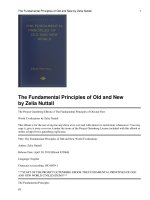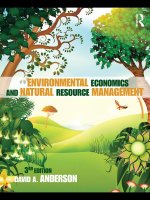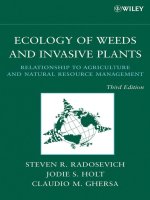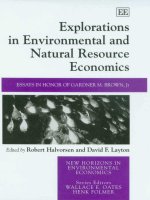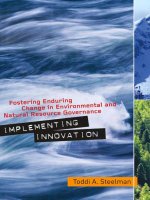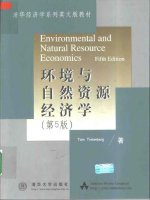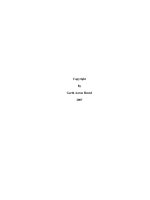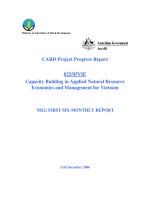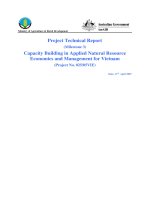Principles of environmental and natural resource economics
Bạn đang xem bản rút gọn của tài liệu. Xem và tải ngay bản đầy đủ của tài liệu tại đây (2.42 MB, 383 trang )
PRINCIPLES OF ENVIRONMENTAL ECONOMICS
This text offers a systematic exposition of environmental and natural resource economics. It presents the
economic and ecological principles essential for a clear understanding of contemporary environmental and
natural resource issues and policy considerations. Environmental and natural resource issues are considered
in a broad, interdisciplinary context that does not treat them as just another subset of applied economics.
The main subject areas include:
•
•
•
•
•
•
•
•
•
basic economic concepts specifically relevant to environmental economics
the economics of natural resource scarcity
ecology, economics and the biophysical constraints to economic growth
ecological economics
the economics of sustainable development
the economics of pollution
valuing the environment
the economics of natural resources
population, development and the environment
The author develops specific tools to illuminate the central problems of environmental economics.
Fundamental economic concepts specifically relevant to environmental and resource economics are
introduced and then integrated with ecological principles and approaches. This text presents an integrated
understanding of environmental and resource economics that acknowledges the disciplinary tie between
economics and ecology.
This student-friendly textbook contains a variety of study tools including learning points, boxed features,
case studies, revision questions and discussion questions. Written in a clear and accessible style, Principles
of Environmental Economics considers a variety of real-world examples to illustrate the policy relevance
and implications of key economic and ecological concepts.
Ahmed M.Hussen is a Professor and Chair of the Department of Economics, Kalamazoo College,
Michigan, USA.
PRINCIPLES OF
ENVIRONMENTAL ECONOMICS
Economics, ecology and public policy
Ahmed M.Hussen
LONDON & NEW YORK
First published 2000 by Routledge
11 New Fetter Lane, London EC4P 4EE
This edition published in the Taylor & Francis e-Library, 2005.
“To purchase your own copy of this or any of Taylor & Francis or Routledge’s collection of thousands of eBooks please go to
www.eBookstore.tandf.co.uk.”
Simultaneously published in the USA and Canada
by Routledge
29 West 35th Street, New York, NY 10001
© 2000 Ahmed M.Hussen
All rights reserved. No part of this book may be reprinted or
reproduced or utilized in any form or by any electronic,
mechanical, or other means, now known or hereafter invented,
including photocopying and recording, or in any information
storage or retrieval system, without permission in writing
from the publishers.
British Library Cataloguing in Publication Data
A catalogue record for this book is available from the British Library
Library of Congress Cataloging in Publication Data
Hussen, Ahmed M.
Principles of environmental economics: economics, ecology and
public policy/Ahmed M.Hussen.
p. cm.
Includes bibliographical references and index.
1. Environmental economics. 2. Ecology. 3. Environmental policy.
I. Title.
HC79.E5H875 1999
333. 7–dc21 99–17809
CIP
ISBN 0-203-45581-9 Master e-book ISBN
ISBN 0-203-76405-6 (Adobe eReader Format)
ISBN 0-415-19570-5 (hbk)
ISBN 0-415-19571-3 (pbk)
Contents
Figures
xiii
Tables
xv
Case studies
xvi
Exhibits
xvii
Preface
xviii
Acknowledgments
xxiii
Introduction
part one
THE ªPREANALYTICº VI SION OF NATURALRESOURCES: THE
STANDARD ECONOMIC PERSPECTIVE
1
xxv
1
The concept of resources and resource scarcity: an economic perspective
2
Learning objectives
2
1.1
Introduction
2
1.2
The concept of resources
3
1.3
Scarcity and its economic implications
4
1.4
A schematic view of the economic process
5
1.5
Applying the concept: ecotourism, cattle ranching and the economy of Costa Rica
8
1.6
Chapter summary
10
Review and discussion questions
11
part two
MARKETS, EFFICIENCY, TECHNOLOGY AND ALTERNATIVE
ECONOMIC INDICATORS OF NATURAL RESOURCE SCARCITY
2
2.1
13
Resource scarcity, economic efficiency and markets: how the invisible hand
works
14
Learning objectives
14
Introduction
14
v
2.2
Basic assumptions
15
2.3
An interpretative analysis of demand, supply and market equilibrium price
16
2.4
Evaluating the performance of a perfectly competitive market economy
21
2.4.1
Consumers’surplus
22
2.4.2
Producers’ surplus and net social benefit
24
2.4.3
Pareto optimality and the Invisible Hand Theorem
25
2.5
Product price as a measure of natural resource scarcity
26
2.6
Chapter summary
31
Review and discussion questions
32
Market signals of natural resource scarcity: resource price, rent and
extraction cost
34
Learning objectives
34
3.1
Introduction
35
3.2
The demand for a factor of production: the case of natural resources
35
3.3
Key variables affecting the supply of a factor of production: the case of natural
resources
37
3.4
Long-run market valuation of a factor of production
39
3.5
Rent and extraction cost as alternative measures of natural resource scarcity
40
3
3.5.1
Differential rent
41
3.5.2
Extraction cost
44
3.6
Factor substitution possibilities, technological changes and resource scarcity
44
3.6.1
Factor substitution
44
3.6.2
Changes in production technology: technical advances
46
3.7
Important caveats
48
3.8
Chapter summary
49
Review and discussion questions
50
part three
ECOLOGY: THE ECONOMICS OF NATURE
4
52
The concept of natural resources: an ecological perspective
53
Learning objectives
53
4.1
Introduction
54
4.2
Ecosystem structure
54
vi
4.3
Ecosystem function
55
4.3.1
Materials recycling
56
4.3.2
Succession, equilibrium, stability, resilience and complexity
57
4.4
The laws of matter and energy
60
4.5
The basic lessons of ecology
62
4.6
Humanity as the breaker of climaxes
63
4.7
Chapter summary
67
Review and discussion questions
68
part four
FUNDAMENTALS OF THE ECONOMICS OF ENVIRONMENTAL
RESOURCES
5
The market, externality, and the ªoptimalº
quality and economic goods
trade-offbetween environmental
70
71
Learning objectives
71
5.1
Introduction
72
5.2
The economic process and the assimilative capacity of the natural environment
73
5.3
Common property resources, external costs and market failure
76
5.3.1
Common property resources and the economic problem
76
5.3.2
Environmental externalities and their economic consequences
78
5.4
Internalizing externality using the Pigouvian tax approach
82
5.5
The macroeconomic effects of environmental regulations: an overview
85
5.6
Chapter summary
87
Review and discussion questions
88
part five
THE PERENNIAL DEBATES ON THE BIOPHYSICAL LIMITATIONS TO
ECONOMIC GROWTH
6
91
Biophysical limits to economic growth: the Malthusian perspective
92
Learning objectives
92
6.1
Introduction
92
6.2
The simple Malthusian growth doctrine: population and resource scarcity
93
6.3
Modified Malthusian models: population, resource use and environmental quality
96
6.3.1
Population and its impact on resource utilization and environmental quality
97
vii
6.3.2
Per capita consumption and its influence on the Population-resource-environment
interrelationship
98
6.3.3
Technology and its influence on the population-resource-environment
interrelationship
99
6.3.4
The basic lessons of the Ehrlich-Commoner model
102
6.4
Has Malthus been discredited?
103
6.5
Chapter summary
105
Review and discussion questions
105
Biophysical limits to economic growth: the neoclassical economic perspective
108
Learning objectives
108
7.1
Introduction
109
7.2
Resource scarcity, technology and economic growth
109
7.3
The classical doctrine of increasing resource scarcity: the empirical evidence
111
7.4
Emerging resource scarcity or abundance: the recent evidence
114
7.5
Economic growth, the environment and population: the neoclassical perspective
117
7.6
Chapter summary
119
Review and discussion questions
120
Biophysical limits to economic growth: the ecological economics perspective
123
Learning objectives
123
8.1
Introduction
124
8.2
Ecological economics: nature and scope
124
8.3
The development of ecological economics: a brief historical sketch
126
8.4
Biophysical limits and their implications for economic growth: an ecological
economic perspective
129
7
8
8.4.1
Kenneth Boulding (1909–93): ecological limits
129
8.4.2
Nicholas Georgescu-Roegen (1906–94): energy as a limiting factor
130
8.4.3
Herman Daly: the steady-state economy
132
8.5
9
Chapter summary
139
Review and discussion questions
140
The economics of sustainable development
142
Learning objectives
142
viii
9.1
Introduction
143
9.2
Sustainable development: a helpful term or a vague and analytically empty concept?
144
9.3
The Hartwick-Solow approach to sustainability
146
9.4
The ecological economic approach to sustainability
150
9.5
The safe minimum standard (SMS) approach to sustainability
153
9.6
Sustainable national income accounting
154
9.7
Chapter summary
157
Review and discussion questions
158
part six
THE ECONOMICS OF ENVIRONMENTAL RESOURCES: PUBLIC
POLICIES AND COST-BENEFIT ESTIMATIONS OF ENVIRONMENTAL
DAMAGE
161
The economic theory of pollution control: the optimal level of pollution
162
Learning objectives
162
10.1
Introduction
162
10.2
Minimization of waste disposal costs
163
10.2.1
Pollution control (abatement) costs
163
10.2.2
Pollution damage costs
165
10
10.3
The optimal level of pollution
168
10.4
Changes in preference and technology and their effects on the optimal level of
pollution
171
10.5
An alternative look at market failure
172
10.6
The optimal level of pollution: an ecological appraisal
173
10.7
Chapter summary
177
Review and discussion questions
178
The economics of environmental regulations: regulating the environment
through judicial procedures
180
Learning objectives
180
11.1
Introduction
180
11.2
Environmental regulation through liability laws
181
11.3
The property rights or Coasian approach
184
11.4
Emission standards
187
11
ix
11.5
Chapter summary
195
Review and discussion questions
196
The economics of environmental regulations: pollution tax and markets for
pollution permits
198
Learning objectives
198
12.1
Introduction
198
12.2
Effluent charges
199
12.3
Transferable emission permits
204
12.4
An evaluation of the emission trading programs in the United States
209
12
12.4.1
Programs to phase out leaded gasoline and ozone-depleting chlorofluorocarbons
(CFCs)
209
12.4.2
The acid rain control program
210
12.5
Chapter summary
213
Review and discussion questions
214
Global environmental pollution: acid rain, ozone depletion and global
warming
216
Learning objectives
216
13.1
Introduction
216
13.2
Causes and consequences of acid rain
217
13.3
Causes and consequences of depletion of the ozone layer
218
13.4
Causes and consequences of global warming
219
13.5
International responses to acid rain, ozone depletion and climate change
220
13.6
The economics of atmospheric pollution
224
13.7
Chapter summary
227
Review and discussion questions
228
The economic theory and measurement of environmental damage (benefit):
valuing the environment
231
Learning objectives
231
14.1
Introduction
232
14.2
Valuation of benefits: the methodological issue
233
14.3
Practical methods of measuring the benefits of environmental improvement
235
13
14
14.3.1
The market pricing approach
236
x
14.3.2
The replacement cost approach
237
14.3.3
Hedonic price approaches
237
14.3.4
The household production function approach
239
14.3.5
The contingent valuation method
241
14.4
Some general problems associated with the economic approach to environmental
valuation
246
14.5
Chapter summary
249
Review and discussion questions
251
A framework for assessing the worthiness of an environmental project: costbenefit analysis
254
Learning objectives
254
15.1
Introduction
255
15.2
The welfare foundation of cost-benefit analysis
256
15.3
The net present value criterion
257
15.4
Private versus public project appraisal
258
15.5
Discounting and intergenerational equity
263
15.6
Chapter summary
264
Review and discussion questions
265
15
part seven
BASIC ELEMENTS OF THE ECONOMIC THEORIES OF RENEWABLE AND
NONRENEWABLE RESOURCES
268
Fundamental principles of the economics of renewable resources: the case of
fishery
269
Learning objectives
269
16.1
Introduction
270
16.2
The natural growth function of biological resources
270
16.3
General characteristics of the natural growth function of fishery populations
272
16.4
The production function of fishery: a steady-state bioeconomic equilibrium model
274
16.5
Economics of fisheries management
279
16.5.1
The open-access equilibrium yield
280
16.5.2
The socially optimal level of effort under private property rights
281
16
16.6
Regulation of fishery: an overview
283
xi
16.7
Some important limitations of the steady-state bioeconomic model
286
16.8
Chapter summary
289
Review and discussion questions
290
Fundamental principles of the economics of nonrenewable resources
293
Learning objectives
293
17.1
Introduction
294
17.2
Assessment of natural resource stocks
295
17
17.2.1
Reserves, resources and resource bases
295
17.2.2
A measure of resource adequacy: reserve-to-use ratio
297
17.2.3
The hypothesis of smooth tonnage grade
297
17.3
The optimal intertemporal allocation of nonrenewable resources
299
17.3.1
Basic assumptions and preliminary analyses
299
17.3.2
The general condition for optimal intertemporal allocation of nonrenewable and
nonrecyclable resources
300
17.3.3
The optimal intertemporal allocation of nonrenewable but recyclable resources
303
17.3.4
Further reflections on the nature of the user cost and some public policy
implications
304
17.4
The optimal price and extraction paths of nonrenewable resources
307
17.4.1
The time path of nonrenewable resource prices
308
17.4.2
The optimal price path and resource exhaustion
310
17.5
Resource prices and extraction rates in the less than perfect world
311
17.6
Resource exhaustion, backstop technology and limits to growth
313
17.7
Chapter summary
315
Review and discussion questions
316
part eight
RESOURCE SCARCITY, POPULATION, POVERTY AND THE
ENVIRONMENT
18
318
Population, development and environmental degradation in the developing
world
319
Learning objectives
319
18.1
Introduction
320
18.2
Growth trends and spatial distribution of global population: a historical perspective
321
xii
18.3
Population control policy: in theory and practice
324
18.3.1
The theory of the demographic transition
325
18.3.2
The microeconomic theory of human fertility
326
18.3.3
Population control through economic incentives
328
18.4
Economic development, population, poverty and environmental degradation
329
18.5
Chapter summary
334
Review and discussion questions
336
Index
338
Figures
1.1
1.2
2.1
2.2
2.3
2.4
2.5
2.6
2.7
2.8
2.9
2.10
2.11
3.1
3.2
3.3
3.4
3.5
3.6
3.7
3.8
3.9
3.10
3.11
4.1
4.2
5.1
5.2
5.3
6.1
6.2
6.3
7.1
7.2
8.1
9.1
10.1
Circular flow diagram of the economic process
The production possibility frontier for Costa Rica
A market demand curve
A shift in market demand curve
A market supply curve
A shift in market supply curve
How the market gravitates toward equilibrium
Long-run market equilibrium price
Consumers’ surplus
Producers’ surplus
Pareto optimality
Roles of market price
Long-run price trend
The market demand for coal
Market conditions in the electricity industry
Market conditions in the coal industry
Market supply of coal
Long-run equilibrium price for coal
Long-run price trend for coal
The concept of rent
The case of differential rent
Factor substitution possibilities
Advances in production techniques
Biased technological advances
Energy flow and material cycling in an ecosystem
Ecologically enlightened economic view (full world scenario)
A simple relationship between economic ouput and waste discharge
Social optimum in the presence of externality: the case of the paper industry
Social optimum through a tax on output
A simple Malthusian growth model
Ehrlich’s model: the impact of population on the environment
Per capita consumption and its effect on the environment
The strong hypothesis of increasing natural resource scarcity
The weak hypothesis of increasing natural resource scarcity
Ends-means spectrum
Trade-offs between intergenerational efficiency and equity
Marginal pollution control cost
7
9
17
17
18
19
21
22
23
25
26
27
30
36
37
37
38
40
41
42
42
45
47
48
56
64
75
81
83
94
98
99
112
114
133
146
165
xiv
10.2
10.3
10.4a
10.4b
10.5
10.6
10.7
11.1
11.2
11.3
11.4
11.5
12.1
12.2
12.3
12.4
14.1
14.2
14.3
15.1
15.2
15.3a
15.3b
16.1
16.2
16.3
16.4
16.5a
16.5b
16.6
16.7
17.1
17.2
17.3
17.4
17.5
17.6
17.7
17.8
18.1
18.2
18.3
Marginal pollution damage cost
Optimal level of pollution
Optimal level of pollution: a numerical illustration
What happens when optimality is not attained?
Effect of technological and preference changes on the optimal level of pollution
Optimal level of pollution
A case where a zero level of waste emission is considered optimal
Marginal damage and control costs of the paper mill
Graphical illustration of the Coase theorem
Emission standards as a policy tool to control pollution
The cost-effectiveness of emission standards
Emission standards and the incentive to improve pollution control technology
Pollution control through effluent charges
Optimal level of effluent charge
Effluent charge and a firm’s incentive to invest in a new pollution control technology
How transferable emission permits work
Demand and supply curves for environmental goods and services
Demand for improved air quality
Change in consumers’ surplus as a measure of social benefit
Demand for improved air quality
The choice between conservation and economic development
The discount factor when r=0.05
The discount factor when r=0.10
Natural growth curve for fishery population
The relationships between harvest, population size and effort
A steady-state bioeconomic equilibrium model of fish harvest
Production function of fishery: the sustainable yield curve
Long-run total revenue, total cost and fishing effort for a fishery
Socially optimal level of fishing effort
Effect of a tax on fishing effort
Effect of a tax on fish catch
The relation of resources to noneconomic materials
Possible geochemical distribution of abundant and scarce elements
Optimal intertemporal allocation of an abundant nonrenewable resource
Optimal intertemporal allocation of a nonrenewable and nonrecyclable resource
Effect of recycling on marginal user cost
Time path of the price of a nonrenewable resource
Price and extraction paths for nonrenewable resources
Backstop technology
Past and projected world population
The demographic transition
Demand and supply curves for children
167
169
170
170
172
173
174
182
185
190
193
194
200
201
202
206
232
234
236
255
256
262
262
273
276
277
279
281
281
284
285
296
298
300
301
304
310
311
314
322
325
327
Tables
4.1
9.1
11.1
14.1
16.1
18.1
18.2
18.3
18.4
Nature’s ecosystem services
How green is your country?
Some of the major environmental laws enacted by the United States Congress, 1938–
90
Total annual consumer surplus (US$) from recreation use and preservation value to
Colorado households from increments in wilderness designation, Colorado, 1980
Examples of precautionary measures
Approximate time taken for the world’s population to grow by a billion
World population growth by decade 1950–90 with projections to 2000
Annual rates of population growth (as percentages) by regions, 1950–85
Population trends, 1900–2000 (millions)
63
156
187
246
288
321
323
323
323
Case studies
1.1
2.1
5.1
8.1
9.1
9.2
10.1
12.1
14.1
15.1
16.1
16.2
17.1
18.1
Economic returns from the biosphere
Ranching for subsidies in Brazil
The economic impact: the 1990 Clean Air Act amendments
Asset recycling at Xerox
Sustainable forest management practice: the case of the Menominee Indian
Reservation
Habitat preservation of endangered fish species in the Virgin River systems: an
application of the safe minimum standard approach
Economic effects of poor indoor air quality
Purchasing pollution
Economics and the Endangered Species Act
Economics and the Endangered Species Act: costs of species protection
The roots of overfishing
Overreacting to overcapacity
Mining the earth
Communal tenure in Papua New Guinea
4
29
86
135
151
153
166
207
242
259
282
285
305
332
Exhibits
1.1
4.1
4.2
4.3
5.1
6.1
6.2
7.1
7.2
7.3
8.1
9.1
10.1
11.1
11.2
11.3
12.1
14.1
Ecotourism, forestland preservation and the economy of Costa Rica
Perpetual motion, a sort of “original sin” in science
The Irish potato famine
Thailand’s shrimp boom comes at great ecological cost
What is the most desirable level of pollution?
Feeding the world: less supply, more demand as summit convenes
Beyond Shiva
Resources, population, environment: an oversupply of false bad news
Energy
Falling birth rates signal a different world in the making
Carrying capacity and ecosystem resilience
What will happen to Saudi Arabia when its oil reserves are eventually exhausted?
An ounce of pollution prevention?
Ore-Ida Foods to pay $1 million for polluting Snake River
Emission standards proposed for marine engines
EPA proposes strict new air quality standards
Acid rain emission limits proposed for over 900 power plants
Toward ecological pricing
7
61
65
66
72
95
103
110
112
118
127
148
175
181
189
190
205
248
Preface
The primary objective of this book is to present the economic and ecological principles essential for a clear
understanding of the complex contemporary environmental and natural resource issues and policy
considerations. Several textbooks have been written on this subject in recent years. One may ask, then, what
exactly differentiates this one from the others?
LEVEL
This book is written for an introductory-level course in environmental and resource economics. It is
primarily designed for college sophomores and juniors who want to study environmental and resource
concerns with an interdisciplinary focus. The academic majors of these students could be in any field of
study, but the book would be especially appropriate for students with majors in economics, political
science, environmental studies or biological sciences.
Several other textbooks may claim to have the above-stated features. However, very few, if any, offer two
chapters that are exclusively designed to provide students with fundamental economic concepts specifically
relevant to environmental and resource economics. In these chapters, economic concepts such as demand
and supply analysis, willingness to pay, consumers’ and producers’ surplus, rent, marginal analysis, Pareto
optimality, factor substitution and alternative economic measures of scarcity are thoroughly and
systematically explained. The material in these two chapters (Chapters 2 and 3) is optional. They are
intended to serve as a good review for economics students and a very valuable foundation for students with
a major in a field other than economics. This book requires no more than a semester course in microeconomics.
Thus, unlike many other textbooks in this field, it does not demand a knowledge of intermediate microeconomics, either implicitly or explicitly.
The claim that environmental and resource economics should be studied within an interdisciplinary
context is taken very seriously. Such a context requires students to have, in addition to microeconomics, a
good understanding of the basic principles of the natural and physical sciences that govern the natural world.
This book addresses this concern by devoting a chapter to ecology. This is done not only to make certain
relevant ecological principles understandable to non-science students, but also to clearly present the
disciplinary tie between economics and ecology. This chapter assumes no prior knowledge in ecology.
Instead, it discusses thoroughly and systematically ecological concepts such as ecosystem, ecosystem
structure, material recycling, the law of matter and energy, entropy, and the interrelationships of succession,
stability, resilience and complexity of ecological systems. These are concepts especially pertinent to the
understanding of biophysical limits and to recent concerns with global issues such as loss of biodiversity
and climate change.
xix
This book is primarily a theoretical exposé of environmental and resource economics. The emphasis is on
a systematic development of theoretical principles and conceptual frameworks essential for a clear
understanding and analysis of environmental and resource issues. To catch students’ imagination and
attention, as well as to reinforce understandings of basic theoretical principles, case studies and “exhibits”
are incorporated into most of the chapters. These are taken from newspaper clippings, brief magazine
articles, articles and summaries of empirical studies from professional journals, and excerpts of publications
from government and private research institutions.
ORIENTATION
Unlike other textbooks in this area, this book is written in the belief that a course in environmental and
resource economics cannot be treated as just another applied course in economics. It must include both
economic and ecological perspectives and, in so doing, must seek a broader context within which
environmental and natural resource issues can be understood and evaluated. In this regard, the book does not
approach environmental and natural resource problems from only or even predominantly a standard economic
perspective.
From my experience of nearly two decades of teaching a course in environmental and resource
economics, I have come to realize that it is extremely difficult for students to understand and appreciate the
subtle differences between the economic and ecological perspectives until they are made aware of the
“axiomatic” foundations (the conceptual starting point of analysis) of each of these perspectives. With this
in mind, this book starts with a careful examination of the preanalytic or axiomatic assumptions of standard
economic perspectives concerning resources, resource scarcity and the role that natural resources play in the
economic process. Similarly, the axiomatic assumptions pertaining to the ecological perspective are
discussed in another chapter. Thus, the clear delineation of the anthropocentric and biocentric views of
natural resources and their scarcity is a unique feature of this textbook.
Most texts on environmental and resource economics are neoclassical in their orientation. For this reason
the emphasis is mainly on intertemporal optimal allocation among alternative uses of the total resource
flow, including the services of the natural environment. In this regard the overriding concern is efficiency.
This book does not disregard the importance of this approach, but it adds to it another important dimension:
the concern for achieving the optimal scale of total resource flow relative to the environment. The key issue
here is to keep the economic scale within the ecological carrying capacity and this requires the recognition
of biophysical limits. Several chapters are assigned to discuss alternative views on biophysical limits to
economic growth and the economics of sustainable development. This, as will be evident shortly, is one of
the most distinguishing features of this book.
xx
ORGANIZATION
The book consists of eighteen chapters which are grouped into eight parts, as shown in the diagram. The
five boxes represent the major organizational themes of the book. As indicated by the direction of the
arrows, these five themes or major groupings are related in both specific and general terms. The exact
nature of these relationships will become evident from the discussions that follow.
Fundamental economic and ecological concepts and perspectives
The four chapters of Parts One, Two and Three constitute what I consider to be the conceptual starting point
of economic and ecological analyses of natural resources and their scarcity. Chapter 1 deals with the
“axiomatic” assumptions that are fundamental to the understanding of the standard economic perception of
natural resources and their role in the economic process. An early explanation of these assumptions, even if
it does not serve to correct logical errors, helps clarify the position neoclassical economists tend to have on
natural resource issues in general.
Chapters 2 and 3 offer comprehensive treatment of all the basic concepts essential for understanding the
economic approach to natural resource and environmental policy. Furthermore, for the most part this is done
using no more than the traditional demand and supply analysis. The two chapters are written with three specific
objectives in mind:
1 To show how, in general, resources are allocated in a competitive market economy.
2 To identify and carefully assess the relative merits of several alternative indicators of emerging natural
resource scarcity.
3 To explain the economic arguments on how scarcity of natural resources can be alleviated through
factor substitution possibilities and/or technological advances. As stated earlier, these two chapters are
optional for students with a strong economic background.
xxi
Chapter 4 is intended to provide students with basic concepts and principles of ecology, thereby
encouraging economics students to venture beyond the realm of their discipline. The position taken here is
that no serious student of environmental and resource economics can afford to be ignorant of the important
lessons of ecology. However, it should be understood that the inquiry on this subject matter is quite focused
and limited. The primary intent is to familiarize students with carefully selected ecological concepts and
principles so that they will acquire at the end, if not appreciation, a clear understanding of ecologists’
perspective of the natural world and its relationship with the human economy. This is also a chapter of vital
importance to the recognition of the existence of biophysical limits.
Environmental externalities and market failure
Part Four, which consists of a single chapter, Chapter 5, represents the second organizational theme of the
text. This part covers fundamental concepts in environmental economics. It demonstrates how the basic
concepts in ecology and economics studied in Parts One, Two and Three can be used to help us understand
and resolve the problem of environmental pollution. Concepts such as the waste absorptive capacity of the
environment, externalities, market failures and environmental regulations and their macroeconomic effects
are discussed in this chapter. These are also concepts which are important to understand for the discussion
in Part Five .
Biophysical limits to economic growth
The four chapters in Part Five are unique in their organization and contain some topics that are rarely
discussed in standard textbooks on environmental and resource economics. The major concern here is the
scale of the economy relative to the natural environment.
Chapters 6, 7 and 8 discuss the limit to economic growth from three distinctive perspectives: Malthusian,
neoclassical and ecological economics, respectively. Chapter 9 deals with the economics of sustainable
development. The key questions that these four chapters address are:
1 Can we expect unlimited economic growth in a world endowed with finite resources?
2 If ecological limits are important factors in determining future trends of economic growth, what steps
or precautions should be taken in order to avoid transgressing these natural limits?
The economics of environmental and natural resources management
The unifying feature of Parts Six and Seven (which consist of Chapters 10–17) is the fact that they deal with
environmental and resource economic issues from a predominantly neoclassical perspective. The emphasis
in these chapters is on “getting the prices right.” That is, environmental resources are optimally allocated
provided market prices reflect their “true” scarcity values.
Chapters 10–15, the economics of environmental resources, deal with the standard economic approaches
to environmental policies and valuations. Chapter 10 develops theoretical models that can be used as a
policy guide to control environmental pollution. In Chapters 11 and 12, a number of pollution control policy
instruments are thoroughly discussed and analyzed. The scientific, economic and public policy issues of
environmental pollution that have a global dimension are discussed in Chapter 13. Chapter 14 examines
alternative economic approaches to measuring environmental benefits (damage). Chapter 15 deals with
economic valuation of environmental projects using a cost-benefit analysis framework.
xxii
Chapters 16 and 17 explore the fundamental principles of the economics of renewable and nonrenewable
resources. Individually, Chapter 16 covers the basic economic theory of renewable resources as it is applied
to biological resources and to fishery in particular. Chapter 17 deals with the basic elements of the
economic theory of nonrenewable resources.
An important point to emphasize here is that even though the seven chapters in Parts Six and Seven are
predominantly neoclassical in their orientation, this should not suggest the total abandonment of the
ecological theme that is central to this text. As much as possible, the major conclusions drawn from each
chapter are subjected to critical appraisal on the basis of their conformity or lack thereof to relevant
ecological principles.
Population, economic development and environmental degradation
Part Eight, which is composed of a single chapter, Chapter 18, analyzes the contemporary population,
resources and environmental problems of the developing nations. The main concerns are poverty and rapid
environmental degradation on a global scale. In addressing these issues, the concern is not only efficiency
but also the scale of the global economy relative to the environment. In this respect, the issues discussed in
this chapter have the added feature of integrating the concepts learned in both Part Five (where scale is the
emphasis) and Parts Six and Seven (where efficiency is the emphasis).
Acknowledgments
The experience of being the sole author of a textbook on a subject which requires an interdisciplinary focus
has indeed been daunting. Undoubtedly, the completion of this project would not have been possible without
the help and encouragement of many professional associates, students and family members. In this sense, I
cannot truly claim to be the sole author of this text.
I am deeply indebted to Fumie, my wife, and Christine R.Fahndrich, my student, who read and edited the
first draft. Nothing written in this text passed to other readers without first being read by my wife.
I would like to thank several individuals for their specific and significant contributions to this text. These
people include the following: Marvin Soroos for authoring Chapter 13 (the chapter on global environmental
pollution); Paul Olexia for his close reading and for his concrete and insightful suggestions on how to
improve the material covered in Chapter 4 (the chapter on ecology); Mike Travis for his very careful
reading of Chapter 16 (the chapter on renewable resources); Glen Britton for his contribution to
Case Study 9.1 and for suggesting alternative approaches and valuable literature bearing on the subject; and
Mike Bernasek for reading and commenting on Part Five (Chapters 6–9), and, most importantly, for his
encouragement.
I would like also to express my deeply felt gratitude to my colleagues from the Economics Department,
Kenneth Reinert, Charles Stull, James Stansell and Phil Thomas, for reading parts of the text and for their
helpful comments and suggestions.
This book uses numerous quoted remarks, exhibits and case studies. These works are not included for
mere appearance or style; they significantly contribute to the effectiveness of the book in conveying certain
important ideas. Obviously, my debt to those whose work I have quoted and summarized is immeasurable.
However, I have the sole responsibility for the interpretation placed on these works.
I actually started writing this book three years ago. However, the idea of writing a textbook on
environmental and resource economics had been on my mind for much of the eighteen years that I have
been actively engaged in teaching courses in this subject. This enduring desire to write a text would not
have been possible without the positive stimulus and, in some instances, tangible support that I have been
fortunate to receive from my students. In this regard, I am deeply indebted to all those who have taken
courses from me dealing with topics on environmental and resource issues.
A special word of thanks to my editor, Alison Kirk, for her thoughtful, professional and supportive role in
the early development of this textbook. Special thanks too to Andreja Zivkovic for his effective editorial
guidance and assistance during the time Alison Kirk was on leave. Many thanks also to Goober Fox for his
cooperative spirit and for his many helpful contributions as desk editor. I would also like to express my
sincere appreciation of the valuable comments I received from several anonymous reviewers during the
various stages of the text development. I am especially indebted to the last group of four anonymous
xxiv
reviewers for their close reading of the entire manuscript and for providing me with concrete ideas and
suggestions as to how the book could be improved.
Finally, I would like to express my sincere gratitude to my two daughters. Sophia and Aida, for their
contributions to proofreading and editing. Most of all, it would have been extremely difficult to complete
this project without their constant cheering and encouragement. I am also forever indebted to Fumie, my
wife, for the continued support, love and unconditional commitment she has shown to me and to our two
daughters. I dedicate this book to her and to the mother of all mothers, the planet EARTH.
